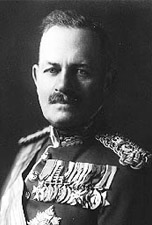Julian H.G. Byng, 1st Viscount Byng of Vimy
|
|
Field Marshall Julian Hedworth George Byng, 1st Viscount Byng of Vimy (11 September 1862–6 June 1935) was a career British Army officer who served as commander of the Canadian army in World War I, and later became Governor-General of Canada.
| Contents |
Early Life
Julian Byng studied at Eton College, and then began a military career in which he saw service in India and the Sudan, and in South Africa during the Boer War of 1899 - 1900. During this campaign, he asked Marie Evelyn Moreton, the only daughter of Sir Richard Charles Moreton, comptroller at Rideau Hall during the term of office of the Marquess of Lorne, to marry him. He was so anxious to receive an answer that he asked her to send her reply by cable. Lord Byng framed her answer, "Yes, please return immediately", and kept it on his desk for the rest of his life. They were married on 30 April 1902, and had no children.
When the First World War came, Byng first campaigned in France with the British Expeditionary Force as commander of the Cavalry Corps, which contained the Canadian Cavalry Brigade. Later, he commanded the 9th Army Corps in the ill-fated Dardanelles Campaign and supervised the withdrawal from the straits. In 1916 he took command of the Canadian Army Corps on the Western Front. With his subordinate General Arthur Currie, he gained his greatest glory with the Canadian victory at the Battle of Vimy Ridge in April 1917, an historic military victory for Canada that inspired nationalism at home. Following this victory, Lord Byng took command of the 3rd British Army, where he conducted the first surprise attack using tanks at Cambrai, considered a turning point in the war. For these services he was promoted to the rank of general, and after the war was raised to the peerage as 1st Baron Byng of Vimy and Thorpe-le-Soken, in Essex, on 7 October 1919. He was appointed Governor General on 2 August 1921. He was very popular in Canada, and during his travels across the country throughout his term of office he was enthusiastically greeted by the men he had led.
Byng as Governor General
Lord Byng's appointment was less controversial than that of his predecessor, the Duke of Devonshire. This was partly due to his popularity but also because he was appointed following direct consultation with the Canadian government. Lord Byng took to his office enthusiastically, further entrenching many of the traditions established by his predecessors. He also broke with tradition and was the first Governor General to appoint Canadian aides-de-camp -- one of them was Georges Vanier, who later served as Governor General from 1959 to 1967.
He was always passionate about sport, and both he and his wife particularly loved ice hockey; Lord Byng rarely missed a game played by the Ottawa Senators. In 1925, Lady Byng presented a trophy to the National Hockey League, which, to this day, recognizes sportsmanship and excellence in play.
Lord and Lady Byng also travelled more than any of their predecessors, making extended trips to western Canada and the North, taking the opportunity to meet with many Canadians. Lord Byng established the Governor General's Cup at the Royal Agricultural Winter Fair, and Lady Byng created a rock garden at Rideau Hall, which still delights visitors today.
The King-Byng Affair
The most notable issue during Lord Byng's term of office was the "King-Byng Affair," a political crisis that arose between the Governor General and Prime Minister William Lyon Mackenzie King. It was watched closely by both the Canadian and British governments, and came to redefine the role of Governor General.
- See King-Byng Affair
Life After Rideau Hall
Following his term as Governor General, Lord and Lady Byng returned to England, where he was created 1st Viscount Byng of Vimy at the end of 1926. He served as Commissioner of the Metropolitan Police and was promoted to the rank of Field Marshal, finally retiring with his wife to Essex, England. Lord Byng died in 1935 and Lady Byng returned to Canada during World War II to live with friends. She died in 1949.
Adapted from http://www.gg.ca (http://www.gg.ca/governor_general/history/bios/byng_e.asp), and http://www.firstworldwar.com (http://www.firstworldwar.com/bio/byng.htm)
| Preceded by: The Duke of Devonshire | Governor General of Canada 1921–1926 | Succeeded by: The Viscount Willingdon
|

